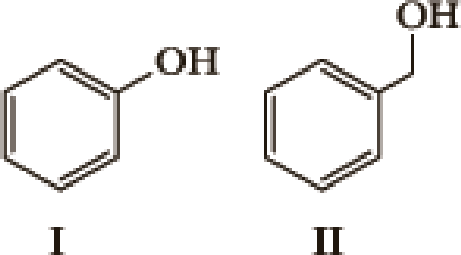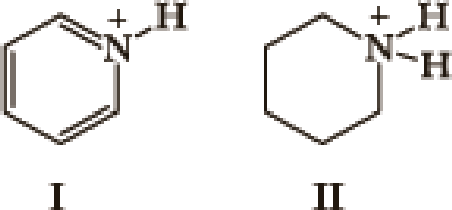
Organic Chemistry
8th Edition
ISBN: 9781305580350
Author: William H. Brown, Brent L. Iverson, Eric Anslyn, Christopher S. Foote
Publisher: Cengage Learning
expand_more
expand_more
format_list_bulleted
Concept explainers
Textbook Question
Chapter 4.6, Problem 1Q
Acid-Base Equilibria
Many factors contribute to the acidity of organic compounds. Electronegativity, resonance, induction, hybridization,





- 1. What factor(s) are the most important to consider when predicting the relative acidity of the two compounds?
- a. Electronegativity of the atom possessing the hydrogen.
- b. Resonance stabilization of the anionic conjugate base.
- c. Inductive stabilization of the anionic conjugate base.
- d. Hybridization of the atom possessing the hydrogen.
- e. The atomic size of the atom possessing the hydrogen.
Expert Solution & Answer
Trending nowThis is a popular solution!

Students have asked these similar questions
Find the pKa of the acids (or conjugate acids of the given base) below. Then, draw the form that is predominant at pH = 3, 7, 12 for each of the compounds:
One way to determine the predominant species at equilibrium for an acid-base reaction is to say that the reaction arrow points to the acid with the higher value of pKa. For example,
Arrange the following organic molecules in order of increasing acidity, starting with the least acidic and explain your answer CH3CH3, HC≡CH and CH2=CH2
Chapter 4 Solutions
Organic Chemistry
Ch. 4.2 - For each conjugate acid-base pair, identify the...Ch. 4.2 - Write these reactions as proton-transfer...Ch. 4.2 - Following is a structural formula for guanidine,...Ch. 4.2 - Write an equation to show the proton transfer...Ch. 4.3 - For each value of Ka, calculate the corresponding...Ch. 4.4 - Predict the position of equilibrium and calculate...Ch. 4.5 - Calculate Keq for a reaction with G0 = 17.1 kJ/mol...Ch. 4.6 - Acid-Base Equilibria Many factors contribute to...Ch. 4.6 - What is the relative trend in acidity and pKa of...Ch. 4.7 - Write an equation for the reaction between each...
Ch. 4 - For each conjugate acid-base pair, identify the...Ch. 4 - Complete a net ionic equation for each...Ch. 4 - Arrange the compounds in each set in order of...Ch. 4 - Prob. 4.12PCh. 4 - In acetic acid, CH3COOH, the OH hydrogen is more...Ch. 4 - Which has the larger numerical value? (a) The pKa...Ch. 4 - In each pair, select the stronger acid. (a)...Ch. 4 - Arrange the compounds in each set in order of...Ch. 4 - Arrange the compounds in each set in order of...Ch. 4 - If the G for a reaction is 4.5 kcal/mol at 298 K,...Ch. 4 - Calculate the Keq for the following reactions from...Ch. 4 - Prob. 4.20PCh. 4 - Answer true or false to the following statements...Ch. 4 - In each of the following three reaction coordinate...Ch. 4 - The acid-base chemistry reaction of barium...Ch. 4 - Unless under pressure, carbonic acid (H2CO3) in...Ch. 4 - Prob. 4.25PCh. 4 - Acetic acid, CH3COOH, is a weak organic acid, pKa...Ch. 4 - Benzoic acid, C6H5COOH (pKa 4.19), is only...Ch. 4 - Prob. 4.28PCh. 4 - One way to determine the predominant species at...Ch. 4 - Will acetylene react with sodium hydride according...Ch. 4 - Prob. 4.31PCh. 4 - For each equation, label the Lewis acid and the...Ch. 4 - Complete the equation for the reaction between...Ch. 4 - Each of these reactions can be written as a Lewis...Ch. 4 - The sec-butyl cation can react as both a...Ch. 4 - Prob. 4.36APCh. 4 - Prob. 4.37APCh. 4 - Prob. 4.38APCh. 4 - Explain why the hydronium ion, H3O+, is the...Ch. 4 - What is the strongest base that can exist in...Ch. 4 - Prob. 4.42APCh. 4 - Prob. 4.43APCh. 4 - Methyl isocyanate, CH3N=C=O, is used in the...Ch. 4 - Offer an explanation for the following...Ch. 4 - Prob. 4.46APCh. 4 - Alcohols (Chapter 10) are weak organic acids, pKa...Ch. 4 - As we shall see in Chapter 19, hydrogens on a...Ch. 4 - 2,4-Pentanedione is a considerably stronger acid...Ch. 4 - Write an equation for the acid-base reaction...Ch. 4 - Prob. 4.51APCh. 4 - Prob. 4.52APCh. 4 - Prob. 4.53APCh. 4 - Following is a structural formula for imidazole, a...
Knowledge Booster
Learn more about
Need a deep-dive on the concept behind this application? Look no further. Learn more about this topic, chemistry and related others by exploring similar questions and additional content below.Similar questions
- Answer true or false to the following statements about the mechanism of acid-base reactions. (a) The acid and base must encounter each other by a collision in order for the proton to transfer. (b) All collisions between acids and bases result in proton transfer. (c) During an acid-base reaction the lone pair on the base fills the A-H antibonding sigma orbital.arrow_forwardHow did you know the molecules were weak or strong acid? Please give the pKa if that's the method you used. Please explain in detail.arrow_forward3. The ranking of the acids in terms of increasing acid strength. 4. The ranking of the conjugate bases in terms of increasing base strength. 5.A justification for the rankings based on the factors that influence the relative stability of the different conjugate bases. I need to answer these for C3H5ClO2, ClCH2CO2, and CH3COOH. (Acetic acid, 3-chloropropanic, and chloroacetic acid). Pleaseeee help I will definitely ratearrow_forward
- Because phenol (C6H5OH) is less acidic than a carboxylic acid, it can be deprotonated by NaOH but not by the weaker base NaHCO3. Using this information, write out an extraction sequence that can be used to separate C6H5OH, benzoic acid, and cyclohexanol. Show what compound is present in each layer at each stage of the process, and if it is present in its neutral or ionic form.arrow_forwardWrite the expression for the acid dissociation constant (Ka), and use the value of Ka as a predictor of acid strength.arrow_forwardRank the following acids in order from weakest acid to strongest acid. Explain why you ranked the acids in the designated order. Your answer should include, if applicable, reasons based in inductive effects, resonance (electron donating groups vs electron withdrawing groups), etc.arrow_forward
- Using pKa Values to Determine Relative Acidity and Basicity Rank the following compounds in order of increasing acidity, and then rank their conjugate bases in order of increasing basicity.arrow_forwardConsider the following compounds that vary from nearly nonacidic to strongly acidic. Draw the conjugate bases of these compounds, and explain why the acidity increases so dramatically with substitution by nitro groups.CH4 CH3NO2 CH2(NO2)2 CH(NO2)3 pKa ≅ 50 pKa = 10.2 pKa = 3.6 pKa = 0.17arrow_forwardGiven that the Ka value for acetic acid is 1.8 × 10−5 and the Ka value for hypochlorousacid is 3.5 × 10−8, which is the stronger base, OCl− or C2H3O2−?arrow_forward
- Identify the acid and conjugate base in each reaction. Calculate the pKA for each acid. List them in order from the strongest to weakest acid. The acid-ionization constants, KA, at 25°C are provided for each. C6H5OH + H2O Û H3O+ + C6H5O-, KA = 1.2589254 x 10-10 CH3CO2H + H2O Û H3O+ CH3CO2-, KA = 1.5848 x 10-5 CF6CO2H+H2O Û H3O+ + CF6CO2-, KA = 0.6309arrow_forwardTheoretical background on how strength of acid affects electrical conductivity with reference to degree of dissociation and basicity min 200-300 wordsarrow_forwardWhich of the following two acids has the stronger conjugate base? Nitrous acid, Ka = 7.1 x 10–4 Phenol, Ka = 1.0 x 10–10 The strength of the conjugate base cannot be obtained from the information given. Nitrous acid, because it has a larger Ka value. Nitrous acid, because it has a smaller Ka value. Phenol, because it has a larger Ka value. Phenol, because it has a smaller Ka value.arrow_forward
arrow_back_ios
SEE MORE QUESTIONS
arrow_forward_ios
Recommended textbooks for you
 Organic ChemistryChemistryISBN:9781305580350Author:William H. Brown, Brent L. Iverson, Eric Anslyn, Christopher S. FootePublisher:Cengage Learning
Organic ChemistryChemistryISBN:9781305580350Author:William H. Brown, Brent L. Iverson, Eric Anslyn, Christopher S. FootePublisher:Cengage Learning Chemistry & Chemical ReactivityChemistryISBN:9781133949640Author:John C. Kotz, Paul M. Treichel, John Townsend, David TreichelPublisher:Cengage Learning
Chemistry & Chemical ReactivityChemistryISBN:9781133949640Author:John C. Kotz, Paul M. Treichel, John Townsend, David TreichelPublisher:Cengage Learning Chemistry & Chemical ReactivityChemistryISBN:9781337399074Author:John C. Kotz, Paul M. Treichel, John Townsend, David TreichelPublisher:Cengage Learning
Chemistry & Chemical ReactivityChemistryISBN:9781337399074Author:John C. Kotz, Paul M. Treichel, John Townsend, David TreichelPublisher:Cengage Learning

Organic Chemistry
Chemistry
ISBN:9781305580350
Author:William H. Brown, Brent L. Iverson, Eric Anslyn, Christopher S. Foote
Publisher:Cengage Learning

Chemistry & Chemical Reactivity
Chemistry
ISBN:9781133949640
Author:John C. Kotz, Paul M. Treichel, John Townsend, David Treichel
Publisher:Cengage Learning

Chemistry & Chemical Reactivity
Chemistry
ISBN:9781337399074
Author:John C. Kotz, Paul M. Treichel, John Townsend, David Treichel
Publisher:Cengage Learning
ENVIRONMENTAL POLLUTION; Author: 7activestudio;https://www.youtube.com/watch?v=oxtMFmDTv3Q;License: Standard YouTube License, CC-BY